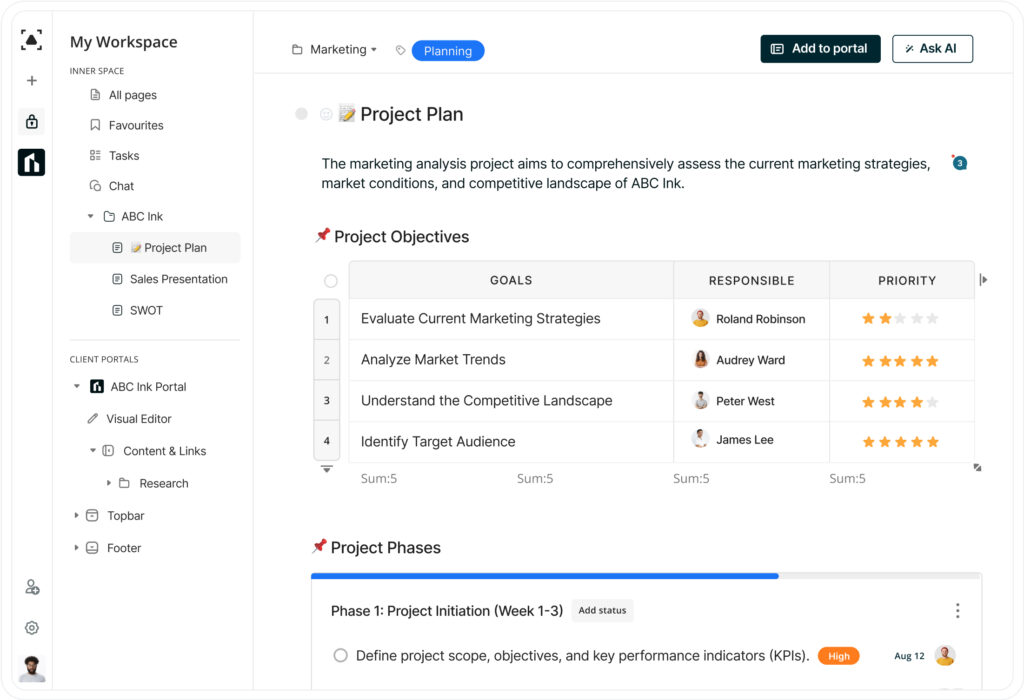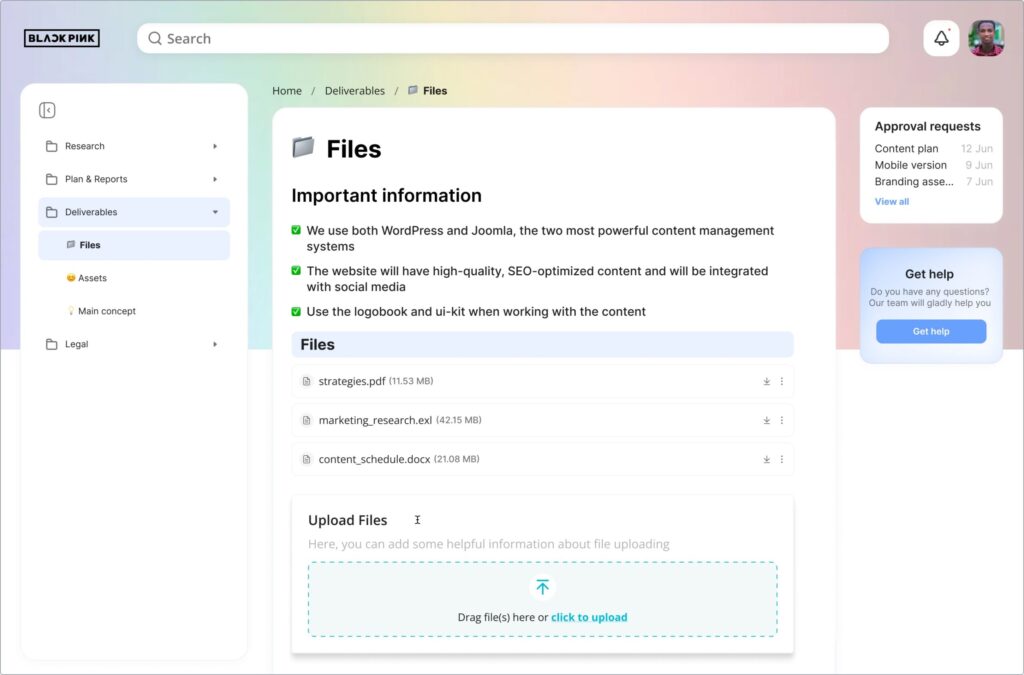- Feb 7, 2024
- 7 Min
How Does Internal Documentation Propel Startup Growth?

Save time with document management tips from experts
Book a demo70% of customers would rather visit a company’s website instead of calling or writing an email to get answers to specific questions. No wonder startups create user manuals, how-to guides, knowledge bases, and other informational documents to publish and attract customers. These materials facilitate product or service usage, ensure saved time getting to know your product or its primary functions, and help you to not get lost in various processes.
However, not only the external audience has such information needs. That’s why every successful startup has to pay attention to internal documentation. A company that wants to ensure proper remote collaboration, grow steadily, and facilitate operations between employees and departments, needs proper documentation — for instance, to onboard new team members. Since only 12% of employees are satisfied with this process, startups invest in internal documentation.
But how can a newborn company handle managing corporate documentation perfectly from scratch? How can you manage remote collaboration and reduce operational issues? This article will show you the connection between making a good product and managing internal documentation. Keep reading to learn more about it!
- How a Lack of Structure and Organization Holds Back Most Startups
- Why Organizing Internal Documentation for Teamwork Matters
- Benefits of Internal Documentation Tools for Startups
- How Internal Documentation Helps Prepare External Work Strategies
- How Can FuseBase Help Your Startup Growth and Internal Documentation?
Startups Often Struggle To Get Structured and Organized
Growth is a natural desire of any startup owner however, a great idea is not enough to bring your business to success. Think of your ambitions as fuel and your internal process as an engine – both need each other to deliver results. Here’s how a poorly designed ‘engine’ may cause troubles on your way.
Why Provide Proper Organization in the First Place
Studies show that startups don’t last for long with flat structures. The most successful companies usually begin with a flat hierarchy and gradually create multiple managerial levels. It’s the best thing to start doing when a startup reaches 20-30 team members.
Some of the Issues Caused by Structural and Organizational Pitfalls
Without proper management, teams lose focus, fail deadlines, and can’t provide appropriate onboarding to newcomers. And this is just the beginning of the widespread hysteria, which, as a result, may lead to:
- Product lags
- Poor customer satisfaction
- Missed tasks
- Poor delegation
- No proper outreach planning
- Lack of knowledge management and transmission between coworkers, new employees, and departments
That’s when internal documentation comes in handy. It’s everything a company needs to deliver and allocate tasks, maintain flawless communication, ensure everyone knows their roles and whether their workflow runs smoothly.
The Importance of Internal Documentation for Teamwork

When we speak about collaboration inside small teams in a startup, it seems like an easy task. First, however, ask yourself several questions:
- Can all your employees name each area they’re responsible for?
- Can they explain their responsibilities step-by-step?
- Can they maintain remote collaboration well?
- If they were hiring a new employee, would they be able to describe their future tasks clearly?
These are a few questions you should be asking yourself and your employees before getting to work. Every new or existing staff member must get as much information about their tasks as their colleagues. This is exactly why you need internal documentation.
It doesn’t just provide you with a lot of saved time — this also brings more clarity and discipline among all departments. Plus, it promotes transparency and more straightforward communication between management and subordinates.
Usually, it’s the small teams that need internal documentation badly. It may seem weird — how come a small company can’t properly allocate tasks between team members?
When a startup begins operating, a few people work on all of the tasks. Everyone takes more responsibilities and it becomes unclear for such a small number of people to manage everything properly without due regulation. A small startup often bootstraps their way to success in their early days but this often leaves a gap for internal documentation.
Tracking everything in one place and having well-organized documentation is essential to scaling your business from people-led to process-led.
What else can internal documentation be helpful for:
- Efficient and fast onboarding of new employees;
- Clear definition of the critical objectives and boundaries;
- More convenient outreach to all the stakeholders, even in terms of remote collaboration;
- Quick task updates and additions like meeting notes or progress tracking;
- Better project management;
- 100% accurate task completion.
Benefits of Internal Documentation Tools
To ensure proper documentation flows and task delivery to the team, it’s not the best option to keep all instructions on paper. In the era of technology and remote work, a digital database is more effective. McKinsey’s report suggests you can increase your team’s productivity from 20% to 25% this way.
Internal documentation tools keep notes, tasks, reminders, SOPs, and everything else in one place. Plus, they provide all the team members with 24/7 access to all the necessary data for productive work and timely task completion. Plus, you can store workflow guides and corporate information and gather your team to work on new ideas together, even if you’re scattered worldwide.
Here’s how tools for corporate documentation create a more balanced working environment inside a startup:
- You’re free to generate ideas and share them with others right away;
- Your team members receive instant updates on the running projects and track the progress of every department;
- Everyone can prepare meeting notes or master creating meeting templates to structure corporate calls and instantly access all the necessary information;
- Employees quickly get what they need: from video scriptwriting and meeting notes to media packs and partnership agreements;
- You may easily integrate services like online calendars, Google Suite, or chatbots with such tools.
Internal Documentation: A Vital Part of External Work Strategies
Okay, now you know how to work properly with data but how can internal documentation create an effective working environment?
First, it’ll be easier for you to arrange your external processes to deliver a good product and maintain effective outreach to your potential and existing clients.
Proper Crisis Management
If internal communication is stable and you’re sure all the processes are running smoothly, you’ll succeed in implementing external strategies. You’ll understand how to promptly react to various issues and provide top service to your clients.
Problem-solving will also become a structured, easy process once you provide step-by-step tutorials on how to help clients with various issues.
Discipline at All Operational Stages
As a result, your team copes with deadlines and complex projects or meetings better and faster. Plus, your colleagues learn how to maintain proper communication with your clients, and the managerial processes become more effective and time-savvy.
A well-trained, disciplined team will ensure all your employees will deliver top-class service to your potential and existing clientele, create a positive brand image, and develop trustworthy relations with partners or stakeholders.
How Can FuseBase Help Your Startup Growth?

Now it’s time to let you know about one of the most convenient and multi-purpose tools for ensuring proper management of all the tasks, meetings, and collaboration between various departments.
FuseBase is a stunning solution for both individual and corporate usage. Once a note-taking app, it became a tool for internal documentation management, creating and sharing notes meetings, and managing corporate manuals and all types of content: from video scriptwriting texts to voice memos, meeting notes, graphs, and images.
The key advantages of FuseBase include the following:
- Super documents for storing multi-format files, highlighting the necessary points, and sorting the information;
- Quick sharing of ideas and information to keep everyone from your team on the same page (even if they don’t have an app);
- White Label for setting up customizable workplaces;
- A transparent structure of folders and subfolders that’ll help you store and share information faster between various departments and projects (during meetings or day-to-day task completion);
- Offline access to check the task flow and work alone whenever suits you best.
FuseBase is a high-end way to maintain proper knowledge management and leverage internal documentation. Use it to improve the outreach to your employees, create comprehensive meeting notes or meeting templates, and instantly share ideas with everyone on the team.
Enhance your internal documentation and communication with FuseBase
FuseBase’s sleek, convenient, and advanced — you can use it literally for every corporate need. Easily manage your tasks or the flow of ideas, track progress, and share new updates with your teammates every time.